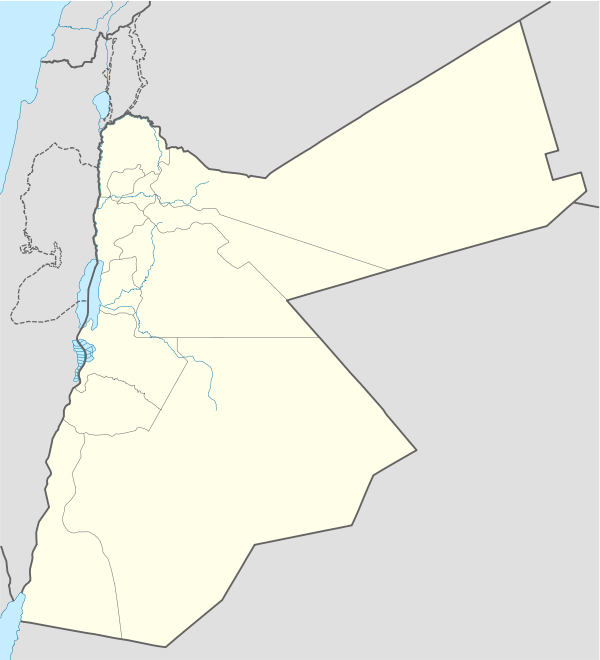Humeima
Humayma, also spelled Humeima, is the modern name of ancient Hawara.[1][2][3] (Arabic: الحميمة) Hawara was a trading post in southern Jordan that was founded by the Nabataean king Aretas III in the early first century BC.[1] It is located 45 km to the south of the Nabataean capital Petra and 55 km to the north of the Red Sea port town of Aqaba.[4]
Arabic: الحميمة | |
 Shown within Jordan | |
| Location | Jordan |
|---|---|
| Region | Aqaba Governorate |
| Coordinates | 29°57′0″N 35°20′49″E |
History
Humeima was occupied from about 90 BC until the early Islamic period,[5] and has Nabataean, Roman, Byzantine and Islamic remains, including a Roman bath and fort, five Byzantine churches, and a qasr or fortified palace from the Umayyad Period.[1][3]
Nabataean and Roman periods
The settlement was founded by Aretas III as a stop on the trade route from Petra to Gulf of Aqaba.[6] During the Greco-Roman era, it was called "Auara" (Greek: Αὔαρα), derived from "Hawara", which means "white" in Aramaic.[7]
Umayyad period
The town was the home of the Abbasid, or Banu Abbas family, around AD 700, who eventually overthrew the Umayyad dynasty and took over the title of caliph, and as such it was the birthplace of the first three Abbasid caliphs: As-Saffah (r. 750–754), Al-Mansur (r. 754–775) and Al-Mahdi (r. 775–785).
Climate
As rainfall is only 80 cm annually, an extensive water storage and irrigation works lies in the ruins.[8][9]
Notable residents
- Abd-Allah ibn Muhammad ibn al-Hanafiyyah (died at the beginning of the 7th century CE in Humayma), an early Muslim jurist and Narrator of hadith
- Muhammad ibn Ali ibn Abdallah, the progenitor of the Abbasid dynasty and a relative of Prophet Muhammad, born in Humayma
See also
- Wadi Rum Al-Kharaza
- Wadi Abu Erouq
- Ar-Rijim
References
- John Peter Oleson. "The history and goals of the Humayma Excavation ProjectT". University of Victoria, British Columbia, Canada. Retrieved 29 July 2019.
- HUMEIMA Copyright 2002.
- Ghazi Bisheh , 2018. 2018."Humayma" in Discover Islamic Art, Museum With No Frontiers.
- Oleson, J. P., “Humaima” in: The Oxford Encyclopaedia of Archaeology in the Near East, (ed) E. M. Meyers, Oxford, 1997, Vol. 3, pp.121–2.
- Humaima Attraction in Aqaba Humayma.
- Ghazi Bisheh , 2018. "Humayma" in Discover Islamic Art, Museum With No Frontiers.
- "Auara, Humayma". Digital Atlas of the Roman Empire.
- HUMEIMA , Copyright 2002.
- Trekking from Petra to Wadi Rum.